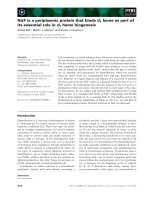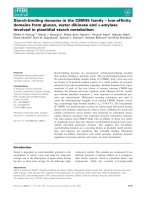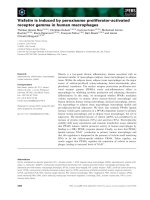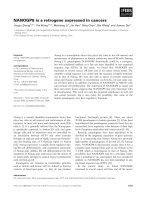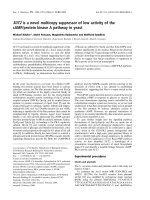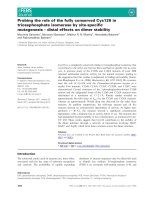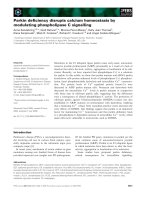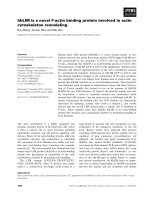báo cáo khoa học: " Ethylene is involved in pistil fate by modulating the onset of ovule senescence and the GA-mediated fruit set in Arabidopsis" docx
Bạn đang xem bản rút gọn của tài liệu. Xem và tải ngay bản đầy đủ của tài liệu tại đây (2.02 MB, 9 trang )
RESEARCH ARTIC LE Open Access
Ethylene is involved in pistil fate by modulating
the onset of ovule senescence and the
GA-mediated fruit set in Arabidopsis
Pablo Carbonell-Bejerano
1,2
, Cristina Urbez
2
, Antonio Granell
2
, Juan Carbonell
2
and Miguel A Perez-Amador
2*
Abstract
Background: Ovule lifespan is an important factor in determining the ability to set fruits and produce seeds. Once
ovule senescence is established, fruit set capacity in response to gibberellins (GAs) is lost. We aimed to elucidate
whether ethylene plays a role in controlling ovule senescence and the fruit set response in Arabidopsis.
Results: Ethylene response inhibitors, silver thiosulphate (STS) and 1-methylcyclopropene (1-MCP), were able to
delay the loss of pistil response to GA
3
. In addition, ethylene insensitive mutants ein2-5 and ein3-1 showed delayed
loss of pistil response, as in plants treated with STS and 1-MCP, while constitutive mutant ctr1-1 displayed
premature loss of response. The analysis of the expression of ethylene biosynthesis genes suggests that ethylene is
synthesised in ovules at the onset of ovule senescence, while a transcriptional meta-analysis also supports an
activated ethylene-dependent senescence upon the establishment of ovule senescence. Finally, a SAG12:GUS
reporter line proved useful to monitor ovule senescence and to directly demonstrate that ethylene specifically
modulates ovule senescence.
Conclusions: We have shown that ethylene is involved in both the control of the ovule lifespan and the
determination of the pistil/fruit fate. Our data support a role of the ovule in modulating the GA response during
fruit set in Arabidopsis. A possible mechanism that links the ethylene modulation of the ovule senescence and the
GA
3
-induced fruit set response is discussed.
Background
The pistil is a highly specialised floral organ designed to
facilitate fertilisation, seed development and dispersal.
Pistils become mature fruits by following a complex
developmental programme triggered by ovule fertilisa-
tion, and by the hormonal signal cascade that follows.
In the absence of this triggering event, the pistil’s auton-
omous developmental programme leads to organ senes-
cence after a few days [1-4].
Pistil senescence has been studied in pea (Pisum sati-
vum)andArabidopsis (Arabidopsis thaliana)plants.
Unpollinated pea pistil senescence involves programmed
cell death, which initiates at 2-3 days post-anthesis
(DPA) [1,5,6]. Its onset correlates with both the expres-
sion of proteolytic activities [7-9] and the whole pistil’ s
cell degradation [2], including DNA fragmentation in
specific cells at both the ovary wall and ovules [6]. More
recently, we showed that the development of the Arabi-
dopsis unfertilised pistil differs from that of pea since
the Arabidopsis ovary wall shows developmental charac-
teristics that are shared with a developing fruit, while
senescence is specifically e stablished first at the stigma,
and then progresses from basal to apical ovules [4].
One physiological marker of pistil senescence in both
pea and Arabidopsis is the loss of the pistil’scapacityto
develop into a parthenocarpic fruit in response to exo-
genous gibberellic acid (GA
3
) [4,5]. The loss of pistil
response to GA
3
in Arabidopsis correlates with the
onset of ovule senescence and its acropetal progression
along the ovary [4] . In a ddition, several mutants with
defects in ovule development showed a reduced fruit set
response to GA
3
[4]. Collectively, these data suggest that
* Correspondence:
2
Instituto de Biología Molecular y Celular de Plantas (IBMCP), Universidad
Politécnica de Valencia (UPV)-Consejo Superior de Investigaciones Científicas
(CSIC). Ciudad Politécnica de la Innovación (CPI), Ed. 8E, Ingeniero Fausto
Elio s/n, 46022 Valencia, Spain
Full list of author information is available at the end of the article
Carbonell-Bejerano et al. BMC Plant Biology 2011, 11:84
/>© 2011 Carbonell-Bejerano et al; licensee BioMed Central Ltd. This is an Open Access article distributed u nder the terms of the Creative
Commons Attribution License ( .0), which permits unrestricted use, distribution, and
reproduction in any medium, provided the original work is properly cited.
viable non-senescing ovules play a critical role in pro-
moting fruit set in response to GA in Arabidopsis unfer-
tilised pistils. The identifi cation of the physiological and
molecular factors regulating pistil/ovule senescence is
important since the pistil’s capacity to develop as a fruit
is lost when senescence is initiated. Therefore by delay-
ing ovule senescence, pistil longevity is expected to
increase. This can lead to important biotechnological
applications because reduced pistil longevity can be a
limiting factor for sexual reproduction and frui t produc-
tion [10-13].
Ethylene is involved in the control o f several terminal
processes during veget ative and rep roductive develop-
ment, including senescence of leaves [14-16], senescence
and abscission of floral organs [3,17-19] and ripening of
fruits [20]. In pea, ethylene regulates both petal and
unfertilised whole pistil senescence [6,21]. Ethylene pro-
duction increases during pea flower senescence, and the
inhibition of ethylene action with silver thiosulphate
(STS) delays senescence symptoms, including a post-
poned los s of the capacity to set part henocarpic fruits in
response to GA
3
[6].
Ethylene signalling has been extensively reviewed in
recent yea rs [22-25]. Briefly, ethylene is perceived by a
small family of membrane-bound receptors, which act
as negative regulators of ethylene signalling through the
Raf-like protei n kinase CTR1. EIN2 is a positive regula-
tor of ethylene response [26] and acts downstream of
CTR1. The EIN3 and EIL1 components are transcrip-
tion fa ctors that act downstream of EIN2 and can acti-
vate ethylene responses.
Thi s work aimed to characterise the ethylene invo lve-
ment in the initiation and progression of Arabidopsis
unpollinated pistil senescence by paying special atten-
tion to the potential effects of this hormone on ovule
senescence and GA-induced frui t set response. Our data
strongly suggest that ethylene modulates the onset of
ovule senescence and, therefore, the time window for
the GA-induced fruit set of pistils in Arabidopsis.
Results
Ethylene signalling modulates pistil responsiveness to
GAs
To test whe ther ethylene plays a role in pistil respon-
siveness to GAs, we first used two inhibitors of ethylene
action, STS and 1-methylcyclopropene (1-MCP) to
check if they affect the elongation triggered by GA
3
when applied to unpollinated pistils. Inhibition of ethy-
lene action postponed the loss of pistil fruit set respon-
siveness to GA
3
by about 1 day (Figure 1). Both STS-
and 1-MCP-treated pistils still maintained a 50%
response at 3 DPA, which is the response shown by
control untreated pistils at 2 DPA. On the other hand,
the inhibitors did not affect the maximum length
reached by parthenocarpic fruits. Therefore, the phar-
macological approach indicates that ethylene plays a
role in modulating the timing of pistil responsiveness to
GAs and, thus, in pistil senescence.
Ethylene’s implication in the control of pistil viability
through the pistil fruit set response to GAs was further
confirmed by a genetic approach. This involved testing
pistil responsiveness to GA
3
in ethylene-insensitive
mutants ein2-5 and ein3- 1, and in the ethylene constitu-
tive response mutant ctr1-1 (Figure 2). Ethylene-i nsensi-
tive mutants showed an approximately one-day delay in
their loss of pistil responsiveness to GA
3
, a similar trend
to that observed for the STS- and 1-MCP-treated pistils.
Conversely, the loss of GA response in ctr1-1 took place
one day earlier if compared to the control. These results
genetically su pport ethylene’s involvement in the modu-
lation of pistil senescence.
Ethylene signalling mutations also affected pistil and
fruit growth. In the completely insensitive ein2-5
mutant, pistils at anthesis were similar to those in par-
ental plants, although the parthenocarpic fruits at 10
Figure 1 Inhibition of ethylene perception delays loss of pistil
fruit set responsiveness to GA
3
. (A) GA response of STS-treated
pistils. Pistil or fruit length in inflorescences treated with 50 μM STS
at 5 and 3 days before GA
3
treatment (●), and in control plants (o).
(B) GA response of 1-MCP treated pistils. Pistil or fruit length in
inflorescences treated daily with 1000 ppm 1-MCP from 1 day
before anthesis to the day of GA
3
treatment (●), and in control
plants (o). Plants were in the cer6-2 background. Unfertilised pistils
of different ages were simultaneously treated with 330 μMGA
3
.
Pistil or fruit length was measured 10 days after GA
3
treatment, and
the data (mean ± SE) were plotted against the pistil age at the time
of treatment. Experiments were repeated three times.
Carbonell-Bejerano et al. BMC Plant Biology 2011, 11:84
/>Page 2 of 9
DPA after GA
3
treatment w ere significantly l arger
(Additional file 1). On the other hand, constitutive ctr1-
1 already displayed significantly shorter pistils at
anthesis, and final fruit length was also significantly
shorter than in parental plants.
Activation of ethylene biosynthesis and response genes
upon unfertilised ovule senescence
A transcriptomic analysis of Arabidopsis unfertilised pis-
tils carried out previously [4] was revisited to indirectly
test whether the ethylene biosynthesis pathway could be
activated in unfertilised pistils. Several genes encoding
ethylene biosynthesis enzymes, 1-aminocyclopropane-1-
carboxylic acid (ACC) OXIDASES (ACOs) and ACO-
like, were u p-regulated at 2 DPA (Figure 3A). The
expression of other genes of the ethylene biosynthesis
was not detected or did not significantly change during
unfertilised pistil development (data not shown). We
studied h ow senescence affects the expression of ACC
SYNTHASE (ACS), the enzyme catalysing the limiting
step in ethylene biosynthesis, in unfertilised ovules by
testing those transgenic lines that express GUS under
the control of ACS promoters [27]. Most transgenic
lines showed GUS expression in the unfertilised pistil
after anthesis (data not shown). One interesting finding
was that ACS2 [TAIR:At1g0 1480] was up-regulated in
the unfertilised ovule; the GUS expression directed by
the ACS2 promoter was detec ted at 2-3 DPA in the
unfertilised pistil and was ovule-specific (Figure 3B). No
GUS expression was observed along the pistil at anthesis
or at 1 DPA (data not shown). It is remarkable to note
that the temporal and spatial gene expression patterns
of genes of the ethylene biosynthesis and GUS activity
in the ACS2:GUS line closely matched the unfertilised
ovule senescence [4].
In view of the fact that the up-regulation of those
genes of the ethylene biosyn thesis was coincident with
the onset of ovule senescence, the ethylene transcrip-
tional response was also analysed. To this end, we made
useofpreviouslypublishedtranscriptomicdataforleaf
senesc ence, which compared the wild-type and the ein2
ethy lene- insensitive mutant [28], and also for the unfer-
tilised pistil’s post-anthesis development [4]. We identi-
fied those genes induced during leaf senescence in the
wild-type, but not in the ein2 mutant (ein2/wt
Figure 2 Ethylene insensitive or constitutive response mutants
show delayed and premature loss of pistil fruit set
responsiveness to GA
3
, respectively. (A) GA response in pistils of
ethylene insensitive mutants ein2-5 (●), ein3-1 (■), and in control
plants (o). (B) GA response in pistils of the ethylene constitutive
response mutant ctr1-1 (●), and in control plants (o). Plants were in
the cer6-2 background. Unfertilised pistils of different ages were
simultaneously treated with 330 μMGA
3
. Pistil or fruit length was
measured 10 days after treatment, and the data (mean ± SE) were
plotted against the pistil age at the time of treatment. Data were
normalised, and the size of the fruits treated at 0 DPA was 100%.
Experiments were repeated three times.
Figure 3 Up-regulation of ethylene biosynthesis genes in
ovules during unfertilised pistil development. (A) Expression
profile of genes of the ethylene biosynthesis differentially expressed
during unfertilised pistil development. Data from the microarray
analysis in [4] were used. ACO, ACC oxidase; ACS, ACC synthase. (B)
GUS expression under the control of the ACS2 promoter in ovules at
2-3 DPA.
Carbonell-Bejerano et al. BMC Plant Biology 2011, 11:84
/>Page 3 of 9
expression ratio below 0.5 [28]), and those up-regulated
in the unfertilised pistil at 2 DPA (genes showing more
than 2-fold change increase of expression between 0
and 2 DPA [4]) (Additional file 2). Of the 78 ethylene-
dependent (EIN2-dependent) leaf senescence-induced
genes [28], 75 were present in both microarray plat-
forms used, of which 25 (33%) were up-regulated in 2
DPA unfertilised pistils (Additional file 2). This implied
a significant enrichment in the EIN2-dependent leaf
senescence-induced genes among those induced in 2
DPA unfertilised pistils (Table 1). On the other hand, a
lower amount (21.7%) of the leaf senescence-induced
genes identified by Buchanan-Wollaston et al. [28] was
also up-regulated in the pistil at 2 DPA (Additional file
2). The significant enrichment in t he senescence-acti-
vated genes dependent on ethylene among the up-regu-
lated genes in the pistil at the onset of ovule senescence
further suggests that ethylene plays a role in the process.
The onset of ovule senescence in unfertilised pistils is
affected in ethylene signalling mutants
The progression of ovule senescence along the pistil
closely matches the loss of pistil growth responsiveness
to GAs [4]. Here we show that ethylene modulates the
initiation of the pistil’ slossofGAresponse.Inaddi-
tion, the expression data also support the activation of
ethylene biosynthesis and response upon the onset of
ovule senescence. To directly test whether ovule senes-
cence could be regulated by ethylene, we analysed the
expression of the senescence marker gene SAG12
[TAIR:At5g45890] in wild-type and ethylene signalling
mutant plants by using a line that expresses GUS
under the control of t he SAG12 prom oter (SAG12:
GUS) [29,30].
In a previous study, we demonstrated that the SAG12
expression was activated in unfertilised pistils shortly
after anthesis, decrea sed afterwards, and increased again
at the end of pistil development, at around 10-12 DPA.
(Additional file 3). In the present study, by following the
GUS expression under the control of the SAG12 gene
promoter during unfe rtilised pistil development in Col-0
plants, we were able to confirm this expression pattern,
which was coincidental with the senescence of ovules
and valves, at 2 and 12 DPA, respectively (Figure 4A
and Additional file 3 inset). GUS activity was first
detected in the ovules at the basal zone of the ovary by
the end of 2 DPA. Afterwards, it progressed acropetally
along the ovary, and had extended to all the ovules by 4
DPA. Strong GUS activity was detected in all the tissues
of pistils at 12 DPA (Ad ditional file 3, inset). By looking
in more detail, we noted that the GUS signal in the
SAG12:GUS line indicated that ovule senescence began
at the chalazal end, and that it later extended to cover
the whole ovule (Additional file 4).
Next we tested the SAG12:GUS expression pattern in
the unfertilised pi stils of ethylene mutants ein2-5 and
ctr1-1. Consistently with the loss of pistil response to
GA
3
(shown in Figure 3), the ethylene-insensitive
mutant exhibited a one-day delay in the initiation of the
ovule senescence (Figure 4B). The ovule senescence of
the ein2-5 mutant initiated at 3 DPA, while it initiated
at 2 DPA in parental plant s (Figure 4A). Once it is
initiated, the progression of ovule senescence in the
ethylene-insensitive mutant followed a similar kinetics
to that in parental plants. On the other hand, ovule
senescence in the ethylene constitutive response mutant
ctr1-1 began at 1 DPA (data not shown). The number of
ovules expressing GUS under the control of the SAG12
promoter in ctr1-1 at 2 DPA was much higher than in
parental plants (Figure 4C). The progression of ovule
senescence in ctr1-1 was similar to that in parental
plants, and like that observed for the ein2-5 mutant.
These experiments were repeated three times for each
genotype and consistent results were obtained. These
results are in agreement with our data obtained using
inhibitors of ethylene action, and reveal that the role of
ethylene in accelerating the onset of ovule senesce nce
without affecting the progression pattern.
Discussion
The experiments described in this article unveil the role
of the hormone ethylene in modulating the o nset of
ovul e senescence in Arabidopsis and, therefore, the per-
iod at which the pistil is co mpetent to set fruits upon
GA
3
treatment. In Arabidopsis and other plant species,
ethylene is dispensable for vegetative or reproductive
development under favourable conditions. Howev er, the
ethylene pathway can prove vital for plant plasticity to
overcome stressing environmental conditions [31-34].
Therefore, the modulation of the ovule lifespan and pis-
til fate by ethylene may be important to ensure seed
production under adverse conditions.
Table 1 Significant enrichment of genes induced during leaf senescence and EIN2-dependent leaf senescence among
those induced in unfertilised pistils from 0 to 2 DPA
Term Genes in platform Positives in pistil % genes in pistil % genes in platform Odds ratio p-value
EIN2-dependent Leaf Senescence 75 25 3.4 0.3 2.65 4.6 E-18
Leaf Senescence 826 179 24.6 3.3 2.28 3.8 E-92
p-value: < 0.05 in a Fisher’s exact test after Benjamini and Hochberg correction. Platform: gene set (20,560 genes) shared by Qiagen-Operon AROS [4] and
Affymetrix ATH1 [28] microarrays. Odds ratio in Log
e
.
Carbonell-Bejerano et al. BMC Plant Biology 2011, 11:84
/>Page 4 of 9
Ethylene modulates pistil competence to develop fruits
Blocking ethylene perception extends the period in
which t he pistil is able to grow in response to exogen-
ous GA in Arabidopsis, thus s upporting similar results
previously described for the unfertilised pea pistil [6].
Thi s sugg ests that ethylene plays a key role in modulat-
ing the timing of pistil senescence in pea and Arabidop-
sis si nce the loss of pistil growth-responsiveness to GA
in both species correlates with the onset of pis til senes-
cence [4,5]. The delay of the loss of the pistil respon-
siveness to GAs by blocking the ethylene response,
using both genetic mutants (ein2-5 and ein3-1)and
pharmacological treatments (1-MCP and STS), further
support the role of ethylene in modulating the fate of
the unfertilised pistils in Arabidopsis. Additional support
derivesfromtheshortenedperiodofpistilresponsive-
ness to GAs in the ctr1-1 constitutive ethylene-response
mutant. However, the lack of ethylene signalling in the
ein mutants, or after inhibiting perception upon STS-
and 1-MCP-treatment, delayed but did not prevent the
loss of fruit set responsiveness to GA. Therefore, ethy-
lene is not necessarily behind the loss of this capacity,
but acts as a modulator of its initiation instead.
Ethylene affects pistil and fruit size
In Arabidopsis, enhanced growth is the major distinctive
characteristic between fruit and unfertilised pistil devel-
opment [4]. The longer final length in both the GA-
induced fruits and unfertilised pistils in the ein2-5 ethy-
lene-insensitive mutant, as well as their smaller size in
the ctr1-1 constitutive ethylene-response mutant, sug-
gest that ethylene controls pistil and fruit growth. A
similar control of adult rosette leaf size by ethylene has
also been reported [35-37]. Given the fact that unferti-
lised pistils and GA-induced fruits grow almost exclu-
sively by cell expansion after anthesis [38], one may
consider that ethylene signalling reduces p istil and fruit
length by reducing cell growth. Increased stabilisation of
DELLA proteins, repressors of GA responses [39], pro-
moted by ethylene signalling via CTR1 may be one of
the causes of growth inhibition, which has already been
proposed for roots [40].
Ovule senescence and ethylene
Ethylene synthe sis is regulated by developmental signals
and other hormones, including GAs, and is enhanced by
stresses, ageing and senescence [25]. Here we show an
incr ease in the activity of ethylene biosynthesis genes in
the ovules of unfertilised pistils. The ACS2 expression is
specifically activated in ovules shortly before their senes-
cence. The ACS2 expression has previously been linked
with floral organ senescence [41]; similarly, a corr elation
between prog rammed cell death and incre ased ethylene
levels during wounding and leaf senescence has been
Figure 4 GUS expression under the c ontrol of the SAG12 gene
promoter during unfertilised pistil development in ethylene
signalling mutants. (A) GUS histochemical assay in unfertilised
pistils of the SAG12:GUS line reveals onset of ovule senescence at 2
DPA, and that senescence progressed acropetally over the next two
days. (B and C) GUS histochemical assay in the unfertilised pistils of
the SAG12:GUS line in (B) ein2-5, and (C) ctr1-1. The onset of ovule
senescence is delayed by 1 day in ein2-5 and is advanced by 1 day
in ctr1-1. Senescence progression follows a similar kinetics as in the
wild-type plant (A). Plants were in the cer6-2 background.
Carbonell-Bejerano et al. BMC Plant Biology 2011, 11:84
/>Page 5 of 9
found [42 ]. In addition, the high expression of an ACC
oxidase [TAIR:At1g12010], specifically in the ovules of 2
DPA unfertilised pistils [4], a lso supports activation of
ethylene biosynthesis upon the i nitiation of senescence
in unfertilized ovules.
Ethylene biosynthesis could be up-regulated as part of
the ovule developmental programme (i.e., ovule ageing)
to precipitate the progress of ovule senescence. There-
fore, increased ethylene synthesis or perception would
result in premature ovule senescence. Indeed, the accel-
erated onset of ovule senescence in the ctr1-1 mutant
supports a causal relationship b etween increased ethy-
lene signal and premature ovule senescence.
Although ethylene modulates the onset of ovule senes-
cence, as indicated by the alteration of the SAG12
expression in the unfertilised ovules of ethylene signal-
ling mutants, our data indicate that ethylene is not abso-
lutely necessary for th e progression of ovule senescence.
A small time window of competence of ethylene has
also been found; for instance, in Alstroemeria flower
senescence and abscission [43], in contrast to other spe-
cies like petunia, where suppressing ethylene action is
able to delay flower senescence for longer periods
[44-46]. The cases described for leaves are also similar
to our results in Arabidopsis pistils: ethylene signalling
also accelerates, but is not strictly necessary for senes-
cence onset in Arabidopsis [14,47], tomato [17] and
Nicotiana sylvestris [48]. An EIN2-dependent modula-
tion of the expression of ageing-regulated factors trig-
gering senescence in leaves has been recently defined
[49], and a similar mechanism may operate in the ethy-
lene signalling-dependent modulation of ovule longevity.
It is possible that the ethylene p roduction rate in
those ovules undergoing senescence increases under
stress co nditions. Indeed, the ethylene response is acti-
vated in pistils after a few hours of salt stress [50], while
approxim ately three quarters of ovules die prior to ferti-
lisation under stress conditions [51]. This mechanism
could reallocate nutrients and energy from senescent
ovules to vital sink organs like developing seeds.
Integration of ethylene into the regulation of ovule
senescence and pistil responsiveness to GA
The modulation o f two temporally correlated processes
by ethylene, progressive ovule senescence along the pis-
til and loss of the pistil fruit set respo nse to GA, and
their alterations observed in ethylene mutants, strongly
indicate a causal relationship. In light of this, we
recently showed that mutants defective in ovule devel-
opment have impaired response to GA
3
in the unferti-
lised pistils [4]. All in all, t hese data suggest that a
viable ovule is required to accomplish adequate pistil
response to GAs, and that ethylene plays a key role in
regulating this response.
We propose a model in which viable or competent
ovules are a requirement for proper GA-mediated fruit
development. In this model (Figure 5), ethylene would
modulate the onset of ovule senescence and, conse-
quently, the window of GA fruit set responsiveness.
Therefore, the final parthenocarpic fruit length would
depend on the number of viable ovules present in the
pistil at the time of GA treatment given the correlation
between the number of non-senescent ovules and the
fruit size rea ched. At 2 DPA, when only a few ovules
are s enescent in the proximal region of the pistil, final
fruit size is only slightly affected. Later at 3 DPA, most
ovules are already senescent and fruit size reaches only
partial length. Finally at 4-5 DPA, when all the ovules
become senescent, the response is completely lost. In
our model, we envision two different scenarios, depend-
ing on where GA perception and signalling are located:
the ovules or the ovary wall. GA perception and/or sig-
nalling may be required in ovules to trigger fruit devel-
opment, and the ethylene produced in ovules would
directly prevent the response, for example, by the stabi-
lisation of the DELLAs via CTR1 [40]. The limited fruit
set r esponse to GA
3
shown by ovule defective mutants
[4] supports this hypothesis.
Besides the direct effect of ethylene on GA signalling
in the ovule, a different hypothesis can also be put f or-
ward. Ethylene could accelerate ovule senescence, which
implies the degradation of all tissues and cell organisa-
tion which, in turn, would disassemble the GA percep-
tion and signall ing machinery. In this case, the effect of
ethylene would be indirect by promoting the degrada-
tion of all tissues in the ovule.
Despite all this evidence, the ind ependence of the pis-
til responsiveness to GA of the ovule fate cannot be
completely ruled out. Elucidation of the location of the
relevant GA perception for fruit development, and the
intercommunication between ovules and other ovary tis-
sues, are essenti al to further define the model. However,
the results obtained in the present work may be consid-
ered to extend ovule longevity using a biotechnological
approach. For instance, expressing an ACC deaminase
transgene or a dominant etr1 mutant allele under the
promoter of a gene specifically activated early after
anthesis in unfertilised ovules may serve to reduce ethy-
lene production/signal and then delay ovule senescence.
Conclusions
The data presented in our manuscript expands the phy-
siological role of ethylene to modulate the onset of
ovule senescence with new consequences for fruit set
and development. Ethylene’s involvement in ovule senes-
cence further supports previous evidences suggesting
that viable and non-senescing ovules are required to
establish the parthenocarpic response in pistils. In
Carbonell-Bejerano et al. BMC Plant Biology 2011, 11:84
/>Page 6 of 9
addition, the present findings may be considered for
biotechnological proposals; for instance, alterations in
the ethylene signalling specifically directed in ovules
could result in the prolongation of the ovule lifespan
and, therefore, in greater seed and fruit yields.
Methods
Plant material
The Arabidopsis thaliana plants used were in the Col0
genetic background, except for 1-MCP and STS treat-
ments, which were in Ler. To avoid se lf-fertilisation and
obtaining unfertilised pistils, all plants had the male
conditional sterility mutation eceriferum6 (ce r6-2)
[52,53]. The ACS2:GUS line and cer6-2 in Ler were
obtained from the Arabidops is Biological Resource Cen-
ter (ABRC, ). cer6-2 in
Col0 was generously provided by Dr. A Vera (Universi-
dad Miguel Hernandez, Spain). The SAG12:GUS trans-
geniclinewasakindgiftfromDr.RMAmasino
(University of Winsconsin, WI, USA). ein2-5, ein3-1,
and ctr1-1 were kindly provided by Dr. JM Alonso
(North Carolina State University, NC, USA). SAG12:
GUS cer6-2, cer6-2 ein2-5, cer6-2 ein3-1, cer6-2 ctr1-1,
SAG12:GUS cer6-2 ein2-5, and SAG12:GUS cer6-2 ctr1-1
plants were generated by genetic cross. Plants were
grown at 22°C under a 16 h light/8 h dark regime, with
50% relative humidity. To determine the age of each pis-
til in the primary inflorescence, the number and position
of flowers at anthesis were recorded every day.
Chemical treatments and fruit set responsiveness assays
Parthenocarpy was assayed by application of GA
3
to unfer-
tilised pistils. Inflorescences were sprayed with 330 μM
GA
3
(Fluka) and 0.01% (v/v) Tween 80, pH 7. Fruits and
pistils were harvested 10 days after treatment, and scanned
to measure final length with the ImageJ software [54].
STS and 1-MCP were used to inhibit ethylene action
during the parthenocarpy responsiveness to GA
3
assay.
For S TS, inflorescences were sprayed with 50 μMSTS,
0.01% Tween 80 at 5 and 3 days before treatment with
GA
3
. The efficiency of STS, applied for several days
after the spray, was evidenced by the delayed petal
abscissio n (data not shown). For each treatment, a fresh
20 mM stock of STS was prepared by mixing a 1:4 (v:v)
ratio of 0.1 M AgNO
3
(Sigma) and 0.1 M Na
2
SO
3
(Sigma). Nearly all the silver in the solution was in the
form of [Ag(S
2
O
3
)
2
]
3-
, which is the active complex for
the inhibition of ethylene action. STS stock solutions
were kept at 4°C in light-tight vessels.
For 1-MCP, pi stils w ere treated daily from 1 day
before anth esis to the day of GA
3
treatment. Two hun-
dred mg of a 1-MCP-releasing powder (SmartFreshTM,
0.14% of active ingredient; Rohm and Haas, Spring-
house, PA, USA) was dissolved in 2.5 mL of water to
provide a final gas concentration of 1000 ppm of 1-
MCP inside a 0.125 m
3
air-tight glass box. Each day,
three flowers at around 1 day before anthesis from 6-9
different primary inflorescences were emasculated to
avoid self-fertilisation due to high humidity. Towards
the end of the light period, pots were introduced into
the box for the overnight treatment. Control plants
were manipulated identically, but without 1-MCP.
b-glucuronidase (GUS) histochemical assay
Samples were harvested and fixed for 30 min in ice-cold
90% acetone, washed once in the rinse buffer [ 50 mM
NaPO
4
buffer, pH 7.0, K
3
Fe(CN)
6
,K
4
Fe(CN)
6
, and 0.2%
Triton X-100], and then vacuum-infiltrated and incu-
bated for 24 h at 37°C in staining buffer (equal to the
rinse buffer but supplemented with 2 mM X-GlcA (5-
bromo-4-chloro-3-indolyl-b-D-glucuronide cyclohexy-
lammonium) (Duchefa). K
3
Fe(CN)
6
and K
4
Fe(CN)
6
, con-
centrations were adjusted for each line (2 mM for
SAG12:GUS or 0.5 mM for ACS2:GUS). After staining,
samples were dehydrated in a series consisting of 20, 35,
50, and 70% (v/v) ethanol. Finally, samples were cleared
for 7 days in chloral hydrate prepared in a solution of
chloral hydrate (Acros Organics, Geel, Belgium):glycerol:
water in a 8:1:2 (g:mL:mL) ratio, and observed under an
Eclipse E600 microscope.
Transcriptional meta-analysis
The significant enrichment of leaf senescence-induced
genes and EIN2-dependent leaf senescence-induced
Figure 5 Model for the ethylene regulation of ovule
senescence and pistil response to GA
3
. Proper ovules would be
required to establish the fruit set response to GAs. Ethylene level
would increase in ovules upon their senescence, accelerating the
process and preventing the GA response. Ethylene can indirectly
affect the GA response mechanism by promoting ovule senescence,
or can also directly interfere with GA signalling (perception and/or
response). GA, gibberellins; Et, ethylene; Sen, senescence.
Carbonell-Bejerano et al. BMC Plant Biology 2011, 11:84
/>Page 7 of 9
ones [28] was tested among those induced from 0 to 2
DPA in the unfertilised pistil [4]. For this purpose, only
the gene set shared by Qiagen-Operon AROS [4] and
Affymetrix ATH1 [28] microarrays (20,560 genes) was
taken into account. Significance, according to a p-value
below 0.05 in a Fisher’s exact test after Benjamini and
Hochberg correction, was analysed by mediating the
Babelomics 4 functional enrichment tools [55].
The full microarray dataset from [4] is availa ble in
accession series in the NCBI GEO (Gene Expression
Omnibus) repository [GEO:GSE13113].
Additional material
Additional file 1: Ethylene signalling affects pistil and fruit length.
Length of the untreated pistil at anthesis (left axis, in mm) and 10-day-
old parthenocarpic fruit induced by GA
3
treatment at anthesis (right axis,
in mm) were measured in the control cer6-2 and ethylene response
mutants ein2-5, ein3-1, and ctr1-1, all of them in the cer6-2 background.
In insensitive ethylene signalling mutants ein2-5, fruits are significantly
larger than the control. Conversely in the constitutive ethylene signalling
mutant ctr1-1, both pistils and fruits are significantly shorter than in the
control. Data are the mean ± SE. Two asterisks indicate significant
differences (p-value < 0.01) with the corresponding cer6-2 control.
Additional file 2: Comparative analysis of the transcriptomic data
from unfertilised pistil senescence and EIN2-dependent leaf
senescence. The expression ratio of the genes up-regulated from 0 to 2
DPA in the unfertilised pistil according to [4] is shown. The ein2/wild-
type expression ratio in leaves undergoing senescence from [28] is
shown for those genes being also up-regulated during leaf senescenc e.
Additional file 3: SAG12 expression during unfertilised pistil
development. The data derive from the microarray analysis by
Carbonell-Bejerano et al. [4]. The SAG12 expression was statistically up-
regulated in a biphasic fashion, with a prominent peak of expression at 2
DPA and a second one at 12 DPA. Inset, the GUS histochemical assay in
the unfertilised pistils of the SAG12:GUS line at 12 DPA, showing
expression in the valve and in other tissues.
Additional file 4: Progression of ovule senescence monitored with
the SAG12 expression in the unfertilised ovules of SAG12:GUS
plants. The SAG12 expression was first detected in ovules at 2 DPA and
extended from outer integuments to inner layers. The expression finally
extended to the chalazal pole by 3 DPA. The expression was never
detected at the micropylar end. ch, chalaza; m, micropyle; i, ovule
integuments; f, funiculus.
Abbreviations
ACC: 1-aminocyclopropane-1-carboxylic acid; ACO: ACC OXIDASE; ACS: ACC
SYNTHASE; DPA: days post anthesis; GAs: gibberellins; GA
3
: gibberellic acid;
GUS: β-glucuronidase; GEO: Gene Expression Omnibus; 1-MCP: 1-
Methylcyclopropene; STS: silver thiosuphfate
Acknowledgements
The authors wish to thank Drs. Alonso and Amasino for their gifts of seeds;
Drs. Alonso, Alabadí, and Blázquez for critically reading the manuscript, and
Ms. Argomániz and Ms. Fuster for technical assistance in the lab. This work
has been supported by grants BIO2005-07156-C02-01 and BIO2008-01039
from the Spanish Ministry of Science and Innovation, Plan Nacional de I+D.
PCB received a PhD fellowship from the Spanish Ministry of Science and
Innovation.
Author details
1
Centro Nacional de Biotecnología (CNB), Consejo Superior de
Investigaciones Científicas (CSIC), Cantoblanco, 28049 Madrid, Spain.
2
Instituto de Biología Molecular y Celular de Plantas (IBMCP), Universidad
Politécnica de Valencia (UPV)-Consejo Superior de Investigaciones Científicas
(CSIC). Ciudad Politécnica de la Innovación (CPI), Ed. 8E, Ingeniero Fausto
Elio s/n, 46022 Valencia, Spain.
Authors’ contributions
PCB generated the plant material and conducted most of the experiments.
CU collaborated in the GUS assay experiments. AG and JC participated in
the experimental design and edition of the manuscript. MAPA coordinated
the study and drafted the manuscript. All the authors have collaborated in
the edition of the manuscript and have approved it.
Received: 4 January 2011 Accepted: 16 May 2011
Published: 16 May 2011
References
1. Carbonell J, Garcia-Martinez JL: Ribulose-1,5-bisphosphate carboxylase
and fruit-set or degeneration of unpollinated ovaries of Pisum sativum L.
Planta 1985, 164:534-539.
2. Vercher Y, Carbonell J: Changes in the structure of ovary tissues and in
the ultrastructure of mesocarp cells during ovary senescence or fruit-
development induced by plant-growth substances in Pisum sativum.
Physiol Plant 1991, 81:518-526.
3. van Doorn WG, Woltering EJ: Physiology and molecular biology of petal
senescence. J Exp Bot 2008, 59:453-480.
4. Carbonell-Bejerano P, Urbez C, Carbonell J, Granell T, Perez-Amador MA: A
fertilization-independent developmental program triggers partial fruit
development and senescence processes in pistils of Arabidopsis. Plant
Physiol 2010, 154:163-172.
5. Garcia-Martinez JL, Carbonell J: Fruit-set of unpollinated ovaries of Pisum
sativum L. Influence of plat-growth regulators. Planta 1980, 147:451-456.
6. Orzaez D, Granell A: DNA fragmentation is regulated by ethylene during
carpel senescence in Pisum sativum. Plant J 1997, 11:137-141.
7. Carrasco P, Carbonell J: Involvement of a neutral proteolytic activity in
the senescence of unpollinated ovaries of Pisum sativum. Physiol Plant
1988, 72:610-616.
8. Carrasco P, Carbonell J: Changes in the level of peptidase activities in pea
ovaries during senescence and fruit set induced by gibberellic acid.
Plant Physiol 1990, 92:1070-1074.
9. Granell A, Harris N, Pisabarro AG, Carbonell J: Temporal and spatial
expression of a thiolprotease gene during pea ovary senescence, and its
regulation by gibberellin. Plant J 1992, 2:907-915.
10. Yi W, Law SE, Wetzstein HY: Fungicide sprays can injure the stigmatic
surface during receptivity in almond flowers. Ann Bot 2003, 91:335-341.
11. Yi W, Law SE, McCoy D, Wetzstein HY: Stigma development and
receptivity in almond (Prunus dulcis). Ann Bot 2006, 97:57-63.
12. Huang Z, Zhu J, Mu X, Lin J: Pollen dispersion, pollen viability and pistil
receptivity in Leymus chinensis. Ann Bot 2004, 93:295-301.
13. Hedhly A, Hormaza JI, Herrero M:
The effect of temperature on stigmatic
receptivity
in sweet cherry (Prunus avium L.). Plant Cell Environ 2003,
26:1673-1680.
14. Grbic V, Bleecker AB: Ethylene regulates the timing of leaf senescence in
Arabidopsis. Plant J 1995, 8:595-602.
15. Lim PO, Kim HJ, Nam HG: Leaf senescence. Ann Rev Plant Biol 2007,
58:115-136.
16. Lim PO, Nam HG: The molecular and genetic control of leaf senescence
and longevity in Arabidopsis. Curr Top Develop Biol 2005, 67:49-83.
17. Lanahan MB, Yen HC, Giovannoni JJ, Klee HJ: The never ripe mutation
blocks ethylene perception in tomato. Plant Cell 1994, 6:521-530.
18. Patterson SE, Bleecker AB: Ethylene-dependent and -independent
processes associated with floral organ abscission in Arabidopsis. Plant
Physiol 2004, 134:194-203.
19. Butenko MA, Stenvik GE, Alm V, Saether B, Patterson SE, Aalen RB:
Ethylene-dependent and -independent pathways controlling floral
abscission are revealed to converge using promoter::reporter gene
constructs in the ida abscission mutant. J Exp Bot 2006, 57:3627-3637.
20. Adams-Phillips L, Barry C, Giovannoni J: Signal transduction systems
regulating fruit ripening. Trends Plant Sci 2004, 9:331-338.
21. Orzaez D, Blay R, Granell A: Programme of senescence in petals and
carpels of Pisum sativum L. flowers and its control by ethylene. Planta
1999, 208:220-226.
Carbonell-Bejerano et al. BMC Plant Biology 2011, 11:84
/>Page 8 of 9
22. Kendrick MD, Chang C: Ethylene signaling: new levels of complexity and
regulation. Curr Op Plant Biol 2008, 11:479-485.
23. Stepanova AN, Alonso JM: Ethylene signaling and response: where
different regulatory modules meet. Curr Op Plant Biol 2009, 12:548-555.
24. Lin Z, Zhong S, Grierson D: Recent advances in ethylene research. J Exp
Bot 2009, 60:3311-3336.
25. Yoo SD, Cho Y, Sheen J: Emerging connections in the ethylene signaling
network. Trends Plant Sci 2009, 14:270-279.
26. Alonso JM, Hirayama T, Roman G, Nourizadeh S, Ecker JR: EIN2, a
bifunctional transducer of ethylene and stress responses in Arabidopsis.
Science 1999, 284:2148-2152.
27. Tsuchisaka A, Theologis A: Unique and overlapping expression patterns
among the Arabidopsis 1-amino-cyclopropane-1-carboxylate synthase
gene family members. Plant Physiol 2004, 136:2982-3000.
28. Buchanan-Wollaston V, Page T, Harrison E, Breeze E, Lim PO, Nam HG,
Lin JF, Wu SH, Swidzinski J, Ishizaki K, Leaver CJ: Comparative
transcriptome analysis reveals significant differences in gene expression
and signalling pathways between developmental and dark/starvation-
induced senescence in Arabidopsis. Plant J 2005, 42:567-585.
29. Lohman KN, Gan S, John MC, Amasino RM: Molecular analysis of natural
leaf senescence in Arabidopsis thaliana. Physiol Plant 1994, 92:322-328.
30. Noh YS, Amasino RM: Identification of a promoter region responsible for
the senescence-specific expression of SAG12. Plant Mol Biol 1999,
41:181-194.
31. Knee EM, Hangarter RP, Knee M: Interactions of light and ethylene in
hypocotyl hook maintenance in Arabidopsis thaliana seedlings. Physiol
Plant 2000, 108:208-215.
32. Achard P, Cheng H, De Grauwe L, Decat J, Schoutteten H, Moritz T, Van Der
Straeten D, Peng J, Harberd NP: Integration of plant responses to
environmentally activated phytohormonal signals. Science 2006,
311:91-94.
33. Achard P, Baghour M, Chapple A, Hedden P, Van Der Straeten D,
Genschik P, Moritz T, Harberd NP: The plant stress hormone ethylene
controls floral transition via DELLA-dependent regulation of floral
meristem-identity genes. Proc Nat Acad Sci, USA 2007, 104:6484-6489.
34. Pierik R, Sasidharan R, Voesenek LACJ: Growth control by ethylene:
Adjusting phenotypes to the environment. J Plant Growth Regul 2007,
26
:188-200.
35. Bleecker AB, Estelle MA, Somerville C, Kende H: Insensitivity to Ethylene
Conferred by a Dominant Mutation in Arabidopsis thaliana. Science 1988,
241:1086.
36. Guzman P, Ecker JR: Exploiting the triple response of Arabidopsis to
identify ethylene-related mutants. Plant Cell 1990, 2:513-523.
37. Kieber JJ, Rothenberg M, Roman G, Feldmann KA, Ecker JR: CTR1, a
negative regulator of the ethylene response pathway in Arabidopsis,
encodes a member of the raf family of protein kinases. Cell 1993,
72:427-441.
38. Vivian-Smith A, Koltunow AM: Genetic analysis of growth-regulator-
induced parthenocarpy in Arabidopsis. Plant Physiol 1999, 121:437-451.
39. Fleet CM, Sun TP: A DELLAcate balance: the role of gibberellin in plant
morphogenesis. Curr Op Plant Biol 2005, 8:77-85.
40. Achard P, Vriezen WH, Van Der Straeten D, Harberd NP: Ethylene regulates
Arabidopsis development via the modulation of DELLA protein growth
repressor function. Plant Cell 2003, 15:2816-2825.
41. Okushima Y, Mitina I, Quach HL, Theologis A: AUXIN RESPONSE FACTOR 2
(ARF2): a pleiotropic developmental regulator. Plant J 2005, 43:29-46.
42. Kim CY, Bove J, Assmann SM: Overexpression of wound-responsive RNA-
binding proteins induces leaf senescence and hypersensitive-like cell
death. New Phytol 2008, 180:57-70.
43. Wagstaff C, Chanasut U, Harren FJ, Laarhoven LJ, Thomas B, Rogers HJ,
Stead AD: Ethylene and flower longevity in Alstroemeria: relationship
between tepal senescence, abscission and ethylene biosynthesis. J Exp
Bot 2005, 56:1007-1016.
44. Wilkinson JQ, Lanahan MB, Clark DG, Bleecker AB, Chang C, Meyerowitz EM,
Klee HJ: A dominant mutant receptor from Arabidopsis confers ethylene
insensitivity in heterologous plants. Nat Biotechnol 1997, 15:444-447.
45. Langston BJ, Bai S, Jones ML: Increases in DNA fragmentation and
induction of a senescence-specific nuclease are delayed during corolla
senescence in ethylene-insensitive (etr1-1) transgenic petunias. J Exp Bot
2005, 56:15-23.
46. Jones ML, Chaffin GS, Eason JR, Clark DG: Ethylene-sensitivity regulates
proteolytic activity and cysteine protease gene expression in petunia
corollas. J Exp Bot 2005, 56:2733-2744.
47. Oh SA, Park JH, Lee GI, Paek KH, Park SK, Nam HG: Identification of three
genetic loci controlling leaf senescence in Arabidopsis thaliana. Plant J
1997,
12:527-535.
48. Yang TF, Gonzalez-Carranza ZH, Maunders MJ, Roberts JA: Ethylene and
the regulation of senescence processes in transgenic Nicotiana sylvestris
plants. Ann Bot 2008, 101:301-310.
49. Kim JH, Woo HR, Kim J, Lim PO, Lee IC, Choi SH, Hwang D, Nam HG:
Trifurcate feed-forward regulation of age-dependent cell death involving
miR164 in Arabidopsis. Science 2009, 323:1053-1057.
50. Sun K, Cui Y, Hauser BA: Environmental stress alters genes expression
and induces ovule abortion: reactive oxygen species appear as ovules
commit to abort. Planta 2005, 222:632-642.
51. Sun K, Hunt K, Hauser BA: Ovule abortion in Arabidopsis triggered by
stress. Plant Physiol 2004, 135:2358-2367.
52. Preuss D, Lemieux B, Yen G, Davis RW: A conditional sterile mutation
eliminates surface components from Arabidopsis pollen and disrupts
cell signaling during fertilization. Genes Develop 1993, 7:974-985.
53. Fiebig A, Mayfield JA, Miley NL, Chau S, Fischer RL, Preuss D: Alterations in
CER6, a gene identical to CUT1, differentially affect long-chain lipid
content on the surface of pollen and stems. Plant Cell 2000, 12:2001-2008.
54. Abramoff MD, Magelhaes PJ, Ram SJ: Image Processing with ImageJ.
Biophotonics International 2004, 11:36-42.
55. Medina I, Carbonell J, Pulido L, Madeira SC, Goetz S, Conesa A, Tárraga J,
Pascual-Montano A, Nogales-Cadenas R, Santoyo J, Garcia F, Marba M,
Montaner D, Dopazo J: Babelomics: an integrative platform for the
analysis of transcriptomics, proteomics and genomic data with
advanced functional profiling. Nucleic Acids Res 2010, 38(Suppl):W210-213.
doi:10.1186/1471-2229-11-84
Cite this article as: Carbonell-Bejerano et al.: Ethylene is involved in pistil
fate by modulating the onset of ovule senescence and the
GA-mediated fruit set in Arabidopsis. BMC Plant Biology 2011 11:84.
Submit your next manuscript to BioMed Central
and take full advantage of:
• Convenient online submission
• Thorough peer review
• No space constraints or color figure charges
• Immediate publication on acceptance
• Inclusion in PubMed, CAS, Scopus and Google Scholar
• Research which is freely available for redistribution
Submit your manuscript at
www.biomedcentral.com/submit
Carbonell-Bejerano et al. BMC Plant Biology 2011, 11:84
/>Page 9 of 9
